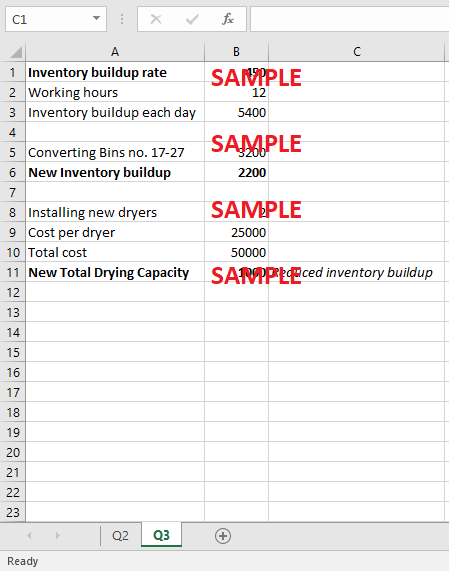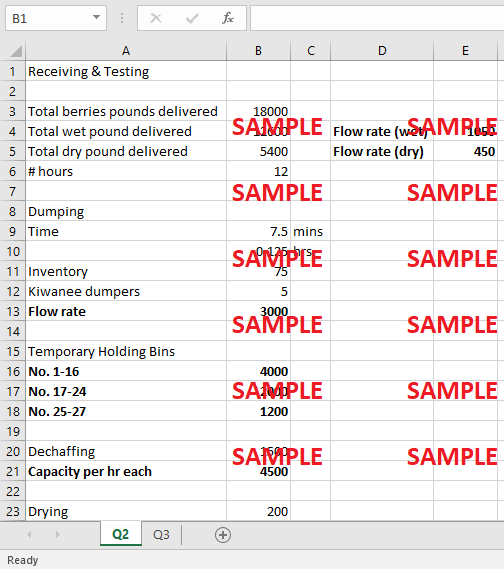Get instant access to this case solution for only $19
National Cranberry Cooperative Case Solution
National Cranberry Cooperative (NCC), a larger co-shared organization formed and owned by cranberry growers, harvests and commercializes its wet and dry berry produce across various North American regions. In rather recent years, nearly 99% of cranberry sales hailed from such cooperatives by and large. After the review of NCC’s process fruit operations for the fall season, several concerning issues were addressed by Hugo Scharffer, the Vice President of Operations, within its receiving plant (RP1). According to the case under scrutiny, high overtime costs and trucks’ waiting line because of over-utilized bins turned out to be the two core operational issues faced by the organization. To process the water-harvested berries in its receiving plant, the following steps are generally deployed: (i) receiving and testing; (ii) dumping; (iii) temporary holding; (iv) de-chaffing; (v) drying; (vi) separation; and (vii) bulking & bagging. The inventory build-up of wet berries by 1050 bbls per hour is troublesome for the organization, whereby the projected percentage of water-harvested berries is to concurrently increase from 58% to 70% this year. Identified through the case information, the bottleneck reigns in its drying system with a capacity to process only 600 bbls of wet berries. The organization ought to install 2 new dryers to remove this bottleneck. Perhaps, the conversion of its temporary bins from dry to wet berries can also cater to its forecasted surplus of water-harvested cranberries to bridge the gap between NCC’s process fruit produced over those utilized.
Following questions are answered in this case study solution
-
What problems is National Cranberry Cooperative (NCC) experiencing, and what potential solutions are mentioned?
-
Analyze the process in Receiving plant #1 that is processing the water-harvested berries. Determine the capacity, bottleneck, and the maximum number of trucks waiting in line.
-
Analyze the impact of starting crews at an earlier time; converting storage bins so that they can be used for water-harvested berries; and installing new dryers.
Case Analysis for National Cranberry Cooperative
1. What problems is National Cranberry Cooperative (NCC) experiencing, and what potential solutions are mentioned?
National Cranberry Cooperative (NCC), a growers-owned organization across North America, is experiencing two primary problems at its receiving plant no. 1 i.e., RP1 amidst the cranberry harvesting period, to be precise: (i) out of control overtime costs despite its investment in a fifth Kiwanee dumper; and (ii) trucks’ waiting for line for growers and drivers whilst unloading of the processed fruit into the receiving plant.
According to Walliston, the superintendent, these problems could be avoided by the next fall through the following proposed solutions:
-
NCC ought to fire up its operations, especially on peak days, in two shifts (7:00 am to 3:00 pm and 3:00 pm to 11:00 pm).
-
NCC ought to install new equipment comprising a few new dryers, projected to cost $25000 each.
-
NCC ought to convert its dry berry holding bins, since the percentage of wet berries has escalated, to permit it to store either water-harvested or dry berries, projected to cost $5000 per bin.
-
NCC ought to install a light meter color grading system to cater to its inexact assessment of berry quality (2B or 3), projected to cost $10000 along with a full-time skilled operator.
2. Analyze the process in Receiving plant #1 that is processing the water-harvested berries. Determine the capacity, bottleneck, and the maximum number of trucks waiting in line.
The handling of the process fruit at RP1 is highly mechanized. The following steps are used to process the water-harvested berries in the receiving plant #1:
1. Receiving and testing:
Flow rate = total wet pounds delivered / # hours
Total berries pound delivered during peak days = approx. 18,000 (refer to Exhibit 2), of which 70% is wet berries expected for FY 1971 -> 12,600
# hours (refer to Exhibit 1) = (1140 – 411)/60 = 12.15 ~ 12 hours
Thereby, flow rate = 12,600/12 = 1050 bbls/ hour (wet)
Get instant access to this case solution for only $19
Get Instant Access to This Case Solution for Only $19
Standard Price
$25
Save $6 on your purchase
-$6
Amount to Pay
$19
Different Requirements? Order a Custom Solution
Calculate the Price
Related Case Solutions
Get More Out of This
Our essay writing services are the best in the world. If you are in search of a professional essay writer, place your order on our website.



